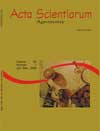<b>Amostragem e variabilidade nos atributos de fertilidade em um latossolo sob plantio direto em São Miguel do Iguaçu, Estado do Paraná</b> - DOI: 10.4025/actasciagron.v25i1.2679
Resumo
Determinou-se o número de subamostras, na linha e entrelinha, para formar uma amostra composta, após o cultivo da soja, em sistema plantio direto, durante nove anos, num Latossolo Vermelho distroférrico, textura argilosa, em São Miguel do Iguaçu, Estado do Paraná. O instrumento de coleta foi o trado de rosca e a profundidade de amostragem foi de 0-15 cm. Considerando uma variabilidade de 90% e um erro em torno da média de 10%, os resultados evidenciaram que: a) a variabilidade nos atributos da fertilidade foi baixa para pH, H+Al, Ca e Mg; foi média para K, MO, Fe e Cu e foi alta para P, Zn e Mn; b) houve maior variação nos resultados para as amostragens feitas na linha, sendo necessário coletar vinte subamostras na linha e treze subamostras na entrelinha, para representar os parâmetros de fertilidade e os nutrientes, exceto o P e Mn; c) as amostragens de solo efetuadas com trado de rosca faz com que haja alta variabilidade nos resultados, em função da menor quantidade de solo, necessitando, por isso, de um maior número de subamostras. Palavras-chave: subamostras de solo, trado de rosca, plantio direto.Downloads
DECLARAÇÃO DE ORIGINALIDADE E DIREITOS AUTORAIS
Declaro que o presente artigo é original, não tendo sido submetido à publicação em qualquer outro periódico nacional ou internacional, quer seja em parte ou em sua totalidade.
Os direitos autorais pertencem exclusivamente aos autores. Os direitos de licenciamento utilizados pelo periódico é a licença Creative Commons Attribution 4.0 (CC BY 4.0): são permitidos o compartilhamento (cópia e distribuição do material em qualqer meio ou formato) e adaptação (remix, transformação e criação de material a partir do conteúdo assim licenciado para quaisquer fins, inclusive comerciais.
Recomenda-se a leitura desse link para maiores informações sobre o tema: fornecimento de créditos e referências de forma correta, entre outros detalhes cruciais para uso adequado do material licenciado.




















































